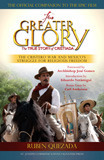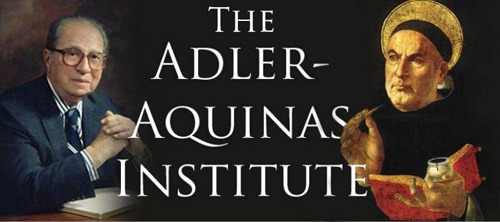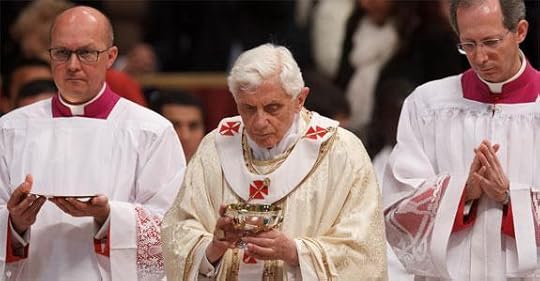Carl E. Olson's Blog, page 220
May 14, 2012
Coming soon: "For Greater Glory: The True Story of Cristiada"
Available in June from Ignatius Press:
by Ruben Quezada
Foreword by Archbishop Jose Gomez
Introduction by Eduardo Verastegui
Many people of faith today are asking, “What is the price of religious liberty?” In the 1920’s many Catholics in Mexico answered this crucial question at the cost of their very lives. The new major motion picture, For Greater Glory: The True Story of Cristiada tells the epic tale of Mexico’s heroic struggle for religious freedom in a little-known conflict called the Cristero War – but many questions still remain. Now you’ll go much deeper into the exciting history behind the movie with this fact-filled companion book – and gain important insight into the on-going fight for religious freedom today.
As you read you’ll discover:
• Who were the Cristeros?
• What drove the Mexican government to ruthlessly persecute Catholics?
• Can a priest “wage war”
• What role did groups like the Knights of Columbus play in this armed resistance?
• Why did thousands of Catholics - priests, religious, lay people - willingly give their lives in the Cristiada?
• What role did the U.S. play in ending this bitter conflict?
• What did the Pope do to support the Church in Mexico?
• Which characters in the movie went on to become Catholic saints and blesseds in real life?
• Why is this dramatic episode of history so little known today?
• What is the lesson of the Cristiada for those struggling for religious freedom today?
“For Greater Glory is a top-flight production whose message of the
importance of religious freedom has particular resonance for us today.”
— Most Reverend Jose Gomez, Archbishop of Los Angeles
“For Greater Glory is ‘must-see’ viewing for all those who care about faith and liberty today.”
— Carl Anderson, Supreme Knight, Knights of Columbus
Here is a bit more about the book:
As the true story of Mexico’s Cristero War for religious liberty opens in theaters June 1, Ignatius Press will publish a companion book to this modern cinematic epic that provides historic perspective and important insight into the ongoing fight for religious freedom today.
For Greater Glory: The True Story of Cristiada is the official companion volume to the film of the same name, which stars Academy Award® nominee Andy Garcia; Golden Globe winner Eva Longoria; legendary Oscar® winner Peter O’Toole; Eduardo Verástegui; and an international cast.
“I am thrilled to see a book of this type become available so everyone can have a deeper understanding of the authentic history behind the terrible persecution portrayed in For Greater Glory - The True Story of Cristiada,” writes Eduardo Verástegui, who plays Blessed Anacleto Gonzalez Flores in the film. Verástegui contributed an introduction to the book. “I sincerely pray such persecution will never be repeated.”
The 150-page volume, loaded with rare and revealing historical and film photos, is written by Ruben Quezada, a recognized expert on the Cristero War and the Cristiada. English and Spanish editions of the book will be in stores June 15. Quezada is Director for the Catholic Resource Center and St. Joseph Communications, Inc., in Southern California, and has travelled internationally as a bilingual speaker giving presentation on the Cristiada.
“It became clear to us that this book was necessary,” said Ignatius Press President Mark Brumley. “Leaders around the country who have attended pre-release screenings are leaving with tremendous interest in bringing to light the full story of the Cristiada, which is impossible to achieve within the time context of a feature theatrical film.
“Ruben Quezada is one of the foremost experts on this historic fight for religious freedom, and we are thrilled that he has provided such a thorough, thoughtful narrative in this book.”
New Ignatius-Angelicum Online College Courses!


Secondary (High/Home School) Level - Great Books Program
Undergraduate (BA) Level - Theology and Philosophy Courses
Graduate (Masters and Doctorate) Level - Adler-Aquinas Institute
Students in the Liberal Studies Program can begin earning up to 48 college credits (1½ years of college) while in high or home school with the Great Books Program from which credits are accepted by numerous colleges and universities.
College-level students can take solid undergraduate theology courses (by Fr. Joseph Fessio, S.J., Th.D. - himself a student of Pope Benedict XVI), and sound philosophy courses designed by renowned Thomist philosopher Dr. Peter A. Redpath (author and for many years professor of philosophy at St. John’s University), augmented by other courses towards one of several bachelor's degrees.
Students may begin the LSP program at any level. In a coordinated LSP course of study, students can obtain a bachelor’s degree from an accredited college for about a fourth of the cost of four years on campus – a savings of approximately $30,000-$125,000 over four years.
Graduate students can apply to masters and doctoral degree programs with concentrations in Philosophy and Religion, or Education, through Harrison Middleton University, a distance education university, in association with the Adler-Aquinas Institute.
For more information, call or text 719-930-7549. Or go online: www.liberalstudiesprogram.org
ANNOUNCING...
Understanding St. Thomas through the Great Books
“Dr. Mortimer J. Adler was the standard bearer of American Thomism – a distinctly American Thomist.” - Dr. Curtis Hancock
The Adler-Aquinas Institute faculty does not consider philosophy to be chiefly a logical system, or a body of knowledge. It considers philosophy to be the act of a habit of soul.
Master’s Programs
Master of Arts in Philosophy and Religion
Master of Arts in Humanities
Doctoral Programs
Doctor of Arts in Philosophy and Religion
Doctor of Education
The theology courses are part of the Philosophy and Religion curriculum of Harrison Middleton University, with related Great Books readings.
Go online: www. adler-aquinasinstitute.org
In association with

www.hmu.edu 1.877.248.6724
The “All” and the “Many”
The “All” and the “Many” | Fr. James V. Schall, S.J. | Catholic World Report
At stake are correct understandings of salvation, divine revelation, and liturgy
“The many bear responsibility for the all. The community of the many must be the lamp on the lampstand, a city on the hilltop, yeast for all. There is a vocation that affects each one of us individually, quite personally. The many, that is to say, we ourselves, must be conscious of our mission to responsibility for the whole.
— Pope Benedict XVI, Letter to Archbishop of Freiburg, April 14, 2012.
I.
Evidently, a number of German bishops maintain that the liturgical translation of the second consecration prayer should still read that this sacrifice is to be offered “for all,” and not for “many.” The German pope is dealing with stubborn German bishops. He promised those bishops he would write a short letter explaining why “for many” is to be used and not “for all.” Benedict XVI notes that they did very little, if anything, to explain the proper reasoning for the “for many” translation.
His letter, sent this past month, sets forth the reasons why “for many” is the proper wording. Basically, it is because those are the words Christ used as reported in the Gospels of Matthew and Mark. The pope again affirms that what Christ said is normative. The bishops’ office is to pass down not their opinions or interpretation but what was given to them all from the beginning.
In dealing with the reasons for this issue, Benedict recalls that, after the Second Vatican Council, some exegetes wanted to use the term “for all” because they thought it referred to Isaiah 53 concerning the Suffering Servant who was to suffer for all. It turns out this exegesis of the text has now been dropped by all scholars. However, a pastoral problem remains. People were led to understand that the words “for all” meant Christ died for everyone, so when the phrase “for many” is used, it seems the scope of salvation was narrowed from all to a few. This dubious understanding caused confusion for many Catholics.
The task to which the pope addressed himself was to explain clearly why the words now in all the canons, “for many,” were the proper ones. In doing so, he emphasized that Christ was indeed sent to save all men. That mission is clear. So why not say so? Here is where something remarkable about this pope comes in. He is so erudite and alert that he foresees problems, real problems, where most of us do not. The use of the term “for all” can easily come to undermine the way in which God, through Jesus Christ, intended to redeem us—that is, all men. If Christ simply came “for all,” it would be easy to make cases for salvation from sources that were not really related to salvation history beginning with Jewish revelation. In fact, this avenue has been a problem as the Holy Father (then Cardinal Joseph Ratzinger) demonstrated in Dominus Iesus, the August 2000 declaration of the Congregation for the Doctrine of the Faith, “On the Unicity and Salvific Universality of Jesus Christ and the Church”.
So what about the use of “for many?”
May 13, 2012
Chesterton on the ties binding fathers, mothers, and children
From The Superstition of Divorce (1920):
The child is an explanation of the father and mother and the fact that it is a human child is the explanation of the ancient human ties connecting the father and mother. The more human, that is the less bestial, is the child, the more lawful and lasting are the ties. So far from any progress in culture or the sciences tending to loosen the bond, any such progress must logically tend to tighten it. ...
When we offer any other system as a "career for women," we are really proposing that an infinite number of them should become servants, of a plutocratic or bureaucratic sort. Ultimately, we are arguing that a woman should not be a mother to her own baby, but a nursemaid to somebody else's baby. But it will not work, even on paper. We cannot all live by taking in each other's washing, especially in the form of pinafores. In the last resort, the only people who either can or will give individual care, to each of the individual children, are their individual parents. The expression as applied to those dealing with changing crowds of children is a graceful and legitimate flourish of speech.
This triangle of truisms, of father, mother and child, cannot be destroyed; it can only destroy those civilisations which disregard it. Most modern reformers are merely bottomless sceptics, and have no basis on which to rebuild; and it is well that such reformers should realise that there is something they cannot reform. You can put down the mighty from their seat; you can turn the world upside down, and there is much to be said for the view that it may then be the right way up. But you cannot create a world in which the baby carries the mother. You cannot create a world in which the mother has no authority over the baby. ...
This nucleus of natural authority has always existed in the midst of more artificial authorities. It has always been regarded as something in the literal sense individual; that is, as an absolute that could not really be divided. A baby was not even a baby apart from its mother...
"We must meditate deeply on the mystery of natural human motherhood..."
..., femininity, and childhood in order to develop on that basis the full understanding of how God chose to redeem us. And a major part of that mystery is the manner in which a child–and this Child most especially, since he has no human father!–derives all its being from its mother. Is it not striking indeed that both in Genesis 3:15-16, when God promises a Redeemer who would "bruise" the head of the serpent, and in Revelation 12:9, when the "ancient serpent" is finally thrown down to earth, it is a woman and a mother who plays an essential role alongside the central activity of the male Child, both as his individual Mother and as Mother of the race of his followers?
How could these two towering moments in the history of revelation–immediately after the Fall and immediately after the final victory over Satan–be divorced from the Incarnation, Golgotha, and Pentecost, pivotal events all three where the Woman Mother is likewise indispensably present? How, after contemplating all of this, could anyone say that Mary is in no way different from any of the rest of the redeemed?
Such an assertion would appear to be a grave violation, not only of orthodox Catholic teaching, but of explicitly revealed scriptural truth. Denying Mary a divinely decreed uniqueness in the work of redemption surely must result in a very skewed and prejudiced theology. Often it would seem that persons holding such an opinion are primarily motivated by an implicit but unrelenting anti-Catholic polemic, ingrained in generations of Protestant believers since the sixteenth century; but with a paradoxical result: that the defeat of a paramount Catholic dogma should be more important than accepting the full truth of revelation.
The Child's dependency on his. Mother, of course, does not contradict what is equally true: that a child grows to maturity and becomes in many ways independent of his parents. However, because we are here dealing with the conception of a Child as a result of divine initiative, and with the corresponding response of faith by a Woman, it would seem that the forces radiating from Mary's first act of faith must extend outward, not only to the actual birth and early nurturing of Jesus, but indeed to his whole subsequent existence, including the events of the Resurrection and of the Savior's present reign in glory.
A conception out of pure power and goodness on God's part, and pure faith and sinlessness on the Mother's part, must surely produce a great deal more than simply a nine-month pregnancy and physical birth! Indeed, it is the beginning of the Body of the Church, the dawn of the Kingdom of God on earth and in heaven. Mary's act of faith and love, as the indispensable condition for the redemption, urgently concerns and involves each of those who have ever or will ever believe and become followers of her Son.
"A voice came out of the cloud, 'This is my beloved Son; listen to him.'" "His Mother said to the servant, 'Do whatever he tells you." Both the heavenly Father and the earthly Mother do one thing only: point to their common Son, Jesus, and command us to obey his word. Thus, the so-called "mediation" of the Blessed Virgin Mary can be properly understood only in terms of her unceasing response to and active cooperation with that coming to her of the Holy Spirit that resulted in the Incarnation. Saint Paul's "until Christ be formed within you" cannot occur without her mediation. For, if she was necessary for the historical Incarnation, the source of all redemption, how is she to be less necessary for Christ's coming to us by the interior grace of regeneration?
From The Way of The Disciple by Erasmo Leiva-Merikakis. Read more:
May 12, 2012
True Love Starts at the Cross
A Scriptural Reflection on the Readings for Sunday, May 13, 2012, the Sixth Sunday of Easter | Carl E. Olson
Readings:
• Acts 10:25-26, 34-35, 44-48
• Ps 98:1, 2-3, 3-4
• 1 Jn 4:7-10
• Jn 15:9-17
“Did I read the same encyclical as The New York Times?”
That was the title of a piece I wrote for the Insight Scoop blog shortly after Pope Benedict XVI’s first encyclical, Deus Caritas Est (“God Is Love”) was released in late December 2005. America’s most famous newspaper ran a piece stating, “Pope Benedict XVI issued an erudite meditation on love and charity on Wednesday in a long-awaited first encyclical that presented Roman Catholicism's potential for good rather than imposing firm, potentially divisive rules for orthodoxy.” It then expressed evident surprise that the encyclical “did not mention abortion, homosexuality, contraception or divorce, issues that often divide Catholics.”
It spoke volumes about the serious misconceptions that exist about the nature of love and Catholicism. For many outside the Church (and, sadly, some inside the Church), being a loving person and being a serious Catholic are not always compatible; some insist they are completely incompatible. After all, goes the wisdom of the day, Catholicism is so exclusive, has so many rules, is so eager to say, “Don’t do this!” and “Don’t do that!” Doesn’t the Church understand that love is in the eye of the beholder—or, more accurately, in the desire of the beholder?
The Holy Father, of course, is aware of these perspectives. He noted that the word “love” has “become one of the most frequently used and misused of words, a word to which we attach quite different meanings” (par 2). He wrote “to clarify some essential facts concerning the love which God mysteriously and gratuitously offers to man, together with the intrinsic link between that Love and the reality of human love” (par 1). In doing so, he drew deeply from 1 John 4 and from the Last Supper Discourse in the Gospel of John (chapters 13-16), from which come today’s Epistle and Gospel readings.
One of Benedict’s essential points is that human love, without a transcendent point of reference, is ultimately incomplete and frustrated. All love comes from the Source of Love, and any attempt—whether intentional or not—to separate love from that Source results in damaging, perverting, and even destroying the love between spouses, family members, friends. Without a vertical, supernatural dimension, love becomes thin and fragile; it begins to crack and crumble under the pressure of everyday life and the ultimate questions that nip at our mental tails.
“This is my commandment: love one another as I love you,” Jesus told his disciples as he prepared to demonstrate his love on the altar of the Cross. “No one has greater love than this, to lay down one’s life for one’s friends.” This is authentic love. It is not rooted in emotion or sentiment, nor is it concerned with mere appearance and respectability. Jesus’ death on the Cross, wrote Benedict, “is love in its most radical form” (par 12). It shows the world that “God is love” (1 Jn 4:8). Any real definition of love must begin at the foot of the Cross, for to look upon and to really see the One who is an expiation for our sins is to know perfect love—not in an abstract way, but in a real and transforming way.
Jesus speaks of love, but also of commandments. This is befuddling to modern man, for he considers love to be freedom from stricture, liberation from directives. But if there is one thing man needs direction in, it is in knowing how to really love, how to die to oneself and to live for others.
God’s commandments are meant to keep us from embracing falsehoods about love; they guide us through the dangerous straits of fleshly temptations and unruly passions. If man followed God’s commandments, there would be no abortions, homosexuality, contraceptives, or divorce. Those evils exist because fallen creatures have pursued faulty notions of love.
And yet, while we each fail to love, we all desire to fall in love. It starts at the Cross and continues by remaining in the One who is Love.
(This "Opening the Word" column originally appeared in the May 17, 2009, issue of Our Sunday Visitor newspaper.)
May 11, 2012
How Fair are Anonymous Accusations Against Priests?
How Fair are Anonymous Accusations Against Priests? | David F. Pierre, Jr. | Catholic World Report
Media reports often presume accused priests are guilty until proven innocent, doing irreparable damage to the lives of the wrongly accused.
When a Catholic priest is publicly accused of the crime of abuse, it is typical for the media to trumpet the name of the cleric, while allowing the accuser to remain completely anonymous throughout the ordeal.
Although this situation is not unique to Catholic priests, it is a practice that clergy have frequently griped about in private, and it is an issue that has received almost no public attention.
For example, last August in Hawaii, a criminal jury took just minutes to acquit Father Bohdan Borowec, a Ukrainian Catholic priest on vacation from Canada, of charges of kidnapping and sexual assault stemming from an incident alleged to have occurred months earlier. Father Borowec had never had any other accusations of wrongdoing against him in decades in ministry.
Throughout the process, Father Borowec had his name and picture plastered across media reports as a “priest charged with rape.” Yet never did the media publish the woman accuser’s name.
Following the exoneration of his client, the priest’s attorney, Shawn A. Luiz, spoke to the Hawaii Catholic Herald and pointed out this glaring double standard. “In cases of being falsely accused, the priest’s reputation is effectively destroyed while the accuser, on the other hand, enjoys anonymity and suffers no loss of reputation or negative material consequences,” Luiz said.
Luiz’s remark may have been a rare instance of such an observation being aired publicly, but it surely is a topic that has been discussed frequently among priests.
Firsthand experience
Rev. Roger N. Jacques was among the clerics swept up in the avalanche of sex abuse claims in the Archdiocese of Boston in 2002. It took nearly four years for the previously unblemished priest to clear his name following a bizarre abuse accusation stemming from a claim of “repressed memory” uncovered through hypnosis.
May 10, 2012
It is now, officially, "Saint Hildegard of Bingen"
From Vatican Information Service:
Vatican City, 10 May 2012 (VIS) - The Holy Father today received in audience Cardinal Angelo Amato S.D.B., prefect of the Congregation for the Causes of Saints. During the audience he extended the liturgical cult of St. Hildegard of Bingen (1089-1179) to the universal Church, inscribing her in the catalogue of saints.
Medievalist Sandra Miesel wrote a CWR article in January about Hildegard of Bingen, titled, "Hildegard of Bingen: Voice of the Living Light". An excerpt:
Nothing would have seemed extraordinary about Hildegard for the first half of her long life. She did not wish to publicize the visionary experiences she had been having since the age of three when a blaze of dazzling brightness burst into her sight. A diffuse radiance which she called her visio filled her field of vision for the rest of her life without interfering with ordinary sight. Hildegard came to understand this phenomenon as “the reflection of the living Light” which conferred the gift of prophecy and gave her an intuitive knowledge of the Divine.
Hildegard’s visions were not apparitions or dreams. She scarcely ever fell into ecstasy but rather perceived sights and messages with the “inner” eyes and ears of her soul. She dictated what she “saw” and “heard” to secretaries while fully lucid. Because the astonishing images she described and directed artists to illustrate feature sparkling gems, shimmering orbs, pulsating stars, curious towers and crenellated walls, modern psychologists have suggested that Hildegard suffered from a form of migraine called “scintillating scotomata.” The debilitating illnesses that preceded or accompanied her visionary episodes might have been migraine attacks. Because supernatural communications are received according to the capacity of the receiver, neurology can offer insights on Hildegard’s particular repertory of forms. But it cannot explain away her experiences or the religious meanings she assigns to them. These were genuine occasions of contact between Hildegard and God.
In 1141—on a date she was careful to record exactly—heaven opened upon Hildegard as “a fiery light of exceeding brilliance” and a mighty voice commanding her to “tell and write” what she sees of God’s marvels. Like Jeremiah and several other prophets, Hildegard quailed at her call. Pleading her sickly female constitution and lack of formal education, she fell ill. But she confided in the convent’s provost, who shared the matter with his abbot at Disibodenberg who urged Hildegard to accept her call. She rose from her bed and set to work on her first book, Scivias.
The connections between work, culture, and liturgy
From a recent post by author and artist David Clayton, who is Thomas More College’s Artist-in-Residence:
It seems at first an unlikely connection but it is made directly in a book called the Wellspring of Worship, by Jean Corbon. I read it because I heard Scott Hahn recommend it recently. It was Hahn’s excellent book the Lamb’s Supper which first made clear to me how the Book of Revelation relates the heavenly and earthly liturgy to each other and first opened the door to a sense of the cosmic dimension of the liturgy upon which so much of the Way of Beauty program rests. Corbon was a Dominican in Beirut who was an Eastern (Melkite I think) Catholic. He is also the person who wrote the section on prayer in the Catechism.
dimension of the liturgy upon which so much of the Way of Beauty program rests. Corbon was a Dominican in Beirut who was an Eastern (Melkite I think) Catholic. He is also the person who wrote the section on prayer in the Catechism.
Corbon wrote the following: ‘Work and culture are the place where men and the world meet in the glory of God. This encounter fails or is obscured to the degree that men “lack God’s glory” (Rom 3:23)… If the experience is to be filled with glory, men must first become once again the dwelling places of this glory and be clothed in it; that is why, existentially, everything begins with the liturgy of the heart and the divinisation of the human person.’ Elsewhere he states that an absense of communion through Eucharistic liturgy ‘that is at the root of injustices in the workplace, with its alienating structures and disorders in the economy.’ (pp 225, 229)
Is the answer to economic problems and injustice in the workplace really the liturgy? This might seem a stretch. However, when one thinks of the nature of economics and the human person (anthropology) the connection seems less obscure.
And, later:
The point that Courbon makes very strongly in his book is the fact that through our participation in the liturgy and this personal relationship with Christ as man, we are divinized. To quote St Athanasius of Alexandria in the 3rd century: ‘God became man that man might become gods.’ We are not fully partaking of the divine nature in this life, but by degrees and to the extent that we actively participate in the liturgy, we are partially divinized in this life. Our ordered participation in any human relationships rests on the foundation of our relationship with God. All the problems of modern society that we care to mention are problems of society and of the culture and are at root problems relating to our personal relationships, for personal relationships are the building block of society. Similarly all that is good in day to day mundane living can be so because of liturgy. Therefore, it is to the degree that we are divine, shining with that same light that was seen at the Transifiguration, that we can act as agents for a good society, a good culture, a good economy. Accordingly, this all depends upon our ordered and active participation in the liturgy.
Read the entire post. Also read the excerpt from Fr. Corbon's book mentioned above by Clayton:
Also see my July 2011 interview with Clayton about the state of the arts:
The Decline of Decadence: A review of "Damsels in Distress"

The Decline of Decadence | Christopher S. Morrissey | Catholic World World
A review of Whit Stillman’s Damsels in Distress, a film depicting the search to be rescued from the rampant boorishness of contemporary culture.
Pope Benedict XVI has observed that “Christianity, Catholicism, isn’t a collection of prohibitions: it’s a positive option. It’s very important that we look at it again because this idea has almost completely disappeared today. We’ve heard so much about what is not allowed that now it’s time to say: we have a positive idea to offer ... I believe we need to see and reflect on the fact that it’s not a Catholic invention that man and woman are made for each other, so that humanity can go on living: all cultures know this.”
Whit Stillman’s new film, Damsels in Distress, offers one of the most positive film endings in recent memory. What most reviewers of the film have neglected to mention is how the film makes a subtle suggestion about authentic Catholicism as a positive, counter-cultural option in the face of dominant cultural trends.
The film’s virtuous heroine, Violet (Greta Gerwig), speaks a number of times about the need to be a good Christian. Most reviewers pass over this important aspect of her character in silence, no doubt for the same reasons that audiences have reportedly gasped out loud in horror at such declarations by Violet.
At first, Violet’s charming naivety seems to be played for laughs, as if she is simply a comic character with an amusing form of mental illness. But by the time the movie ends, the audience is challenged to ask themselves: Isn’t Violet’s crazy dream-world in fact preferable? Is hers not the most beautiful way of choosing to transfigure the real world? Isn’t it really the dominant culture—concretely symbolized by the movie’s decadent “Cathar” heretic, Xavier (Hugo Becker)—that is truly crazy?
Carl E. Olson's Blog
- Carl E. Olson's profile
- 20 followers


 For Greater Glory: The True Story of Cristiada The Cristero War and Mexico's Struggle for Religious Freedom
For Greater Glory: The True Story of Cristiada The Cristero War and Mexico's Struggle for Religious Freedom







